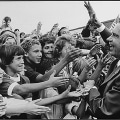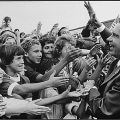As an expert in political campaigns, I have seen firsthand the impact of location on the strategies and tactics used by candidates. In Southeast Texas, the region is divided into urban and rural areas, each with its own unique characteristics. While both areas may share similar issues and concerns, the approach to campaigning can vary greatly.
The Urban Landscape
Urban areas in Southeast Texas, such as Houston and Beaumont, are densely populated with diverse communities. These areas are typically more politically active and have a higher voter turnout compared to rural areas.As a result, candidate campaigns in urban areas tend to be more competitive and intense.
Candidate campaigns in Southeast Texas
urban areas often rely heavily on media coverage and advertising to reach a larger audience. With a larger pool of potential voters, candidates must invest more resources into their campaigns to stand out from their opponents. This means spending more money on television and radio ads, billboards, and social media campaigns. Another key difference in urban campaigns is the use of endorsements. In densely populated areas, there are often numerous organizations and influential individuals that can endorse a candidate.These endorsements can carry significant weight with voters and can help sway their decision.
Urban campaigns also tend to focus on specific issues that are relevant to the community.
For example, in Houston, candidates may focus on issues such as traffic congestion, public transportation, and affordable housing. In Beaumont, candidates may prioritize issues such as hurricane preparedness and economic development.The Rural Landscape
Rural areas in Southeast Texas, such as Orange and Jasper, have a smaller population and are more spread out. This means that candidate campaigns in rural areas have a more personal touch and rely heavily on grassroots efforts. In rural areas, candidates often have to travel long distances to reach potential voters. This means that door-to-door campaigning and attending local events are crucial for candidates to connect with voters.Unlike urban areas, where media coverage is more prevalent, rural campaigns rely more on word-of-mouth and personal interactions.Another key difference in rural campaigns is the use of traditional media. While urban campaigns may focus on digital and social media, rural campaigns still utilize traditional forms of media such as local newspapers and radio stations. These forms of media are often more trusted by rural voters and can be an effective way for candidates to reach them.
Rural campaigns also tend to focus on broader issues that affect the entire region.
For example, in Orange, candidates may prioritize issues such as agriculture and rural development. In Jasper, candidates may focus on issues such as natural resource management and infrastructure improvements.The Role of Demographics
Aside from the location, demographics also play a significant role in shaping candidate campaigns in Southeast Texas. Urban areas tend to have a more diverse population, with a mix of different ethnicities, ages, and income levels.This means that urban campaigns must appeal to a wider range of voters and tailor their messaging accordingly.Rural areas, on the other hand, tend to have a more homogenous population with similar backgrounds and values. This means that rural campaigns can focus on a specific demographic and tailor their messaging to resonate with them.
The Importance of Personal Connections
In both urban and rural areas of Southeast Texas, personal connections play a crucial role in candidate campaigns. However, the approach to building these connections may differ. In urban areas, candidates may rely more on endorsements and media coverage to build their credibility and connect with voters. In contrast, rural campaigns place a greater emphasis on personal interactions and building relationships with voters. This can include attending local events, speaking at community gatherings, and participating in town hall meetings.The Bottom Line
While there are many similarities between candidate campaigns in urban and rural areas of Southeast Texas, the key differences lie in the strategies and tactics used to reach voters.Urban campaigns tend to be more competitive and rely heavily on media coverage and endorsements, while rural campaigns focus on grassroots efforts and traditional forms of media. Understanding these differences is crucial for candidates to run successful campaigns in both urban and rural areas of Southeast Texas.





